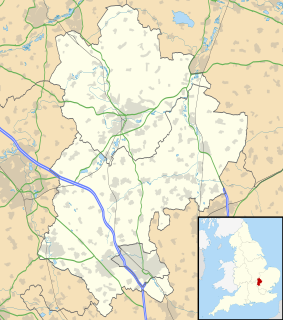Related Research Articles
The South Midlands League was a football league covering Bedfordshire and some adjoining counties in England. It was founded in 1922 as the Bedfordshire County League and merged with the Spartan League in 1997 to form the Spartan South Midlands League.

Sharnbrook Academy, formerly Sharnbrook Upper School until 2017, is a large, rural academy school located in Sharnbrook, a village in the English county of Bedfordshire. Built in 1975, the school now has over 1900 students and around 300 staff, and includes a large sixth form founded in 1978 of around 650 students.

Riseley is a village and civil parish located in North Bedfordshire, England. The village name has had alternative spellings in the past such as Rislau, Riseleg, Riselai and Risely, however all these spellings are considered archaic. It has a population of 1,284 according to the 2001 census, increasing to 1,286 at the 2011 Census, and is near the villages of Bletsoe, Sharnbrook, Swineshead, Pertenhall, Keysoe, Thurleigh and Melchbourne. The nearest town to Riseley is Rushden in the neighbouring county of Northamptonshire, approximately 8 miles away to the north west. The county town of Bedford is approximately 9 miles to the South of Riseley. The village has one watercourse, which is a tributary of the River Ouse, flowing through it known locally as the 'Brook' around which in medieval times the village was built.

The Hundred of Willey is a historical land division, a hundred in the northwest corner of Bedfordshire, England. Its northwestern boundary is the county border with Northamptonshire, and its southwestern boundary the border with Buckinghamshire. Some of its parishes and settlements lay on the River Great Ouse which flows through the hundred.

The Priory Church of St Peter with its monastery was founded in 1132 by Henry I for Augustinian Canons in Dunstable, Bedfordshire, England. St Peter's today is only the nave of what remains of an originally much larger Augustinian priory church. The monastic buildings consisted of a dormitory for the monks, an infirmary, stables, workshops, bakehouse, brewhouse and buttery. There was also a hostel for pilgrims and travellers, the remains of which is known today as Priory House. Opposite the Priory was one of the royal palaces belonging to Henry I, known as Kingsbury.
This is a list of High Sheriffs of Bedfordshire.

Buckland Priory was established around 1167 in Lower Durston, Somerset, England.

Caldwell Priory was a priory of Canons of the Holy Sepulchre in Bedfordshire, England, from circa 1154 to 1536. It was situated in the south-west of Bedford on the south bank of the River Great Ouse.
Grovebury Priory, also known as La Grave or Grava was a priory in Leighton Buzzard, Bedfordshire, England. It was established in 1164 and disestablished in 1414.
Harrold Priory was a priory in Harrold, Bedfordshire, England. It was established in 1138 and disestablished in 1536.

Markyate Priory was a Benedictine priory in Bedfordshire, England. It was established in 1145 and disestablished in 1537.
Newnham Priory was a priory in Newnham, Bedford, Bedfordshire, England.

Bradbourne Priory was a priory in Bradbourne, Derbyshire, England.
Great Limber Preceptory, Limber Magna was a Camera (farm) of the Knights Templar and later the Knights Hospitaller in the village of Great Limber, Lincolnshire, England.

Ossington Preceptory was a preceptory of the Knights Hospitaller, near to the village of Ossington in Nottinghamshire, England.
References
- 1 2 3 4 Page, William; Doubleday, Herbert Arthur The Victoria History of the County of Bedford: Volume 1, 1904, p.394
- ↑ "Parishes: Souldrop | British History Online".
- ↑ Page, William; Doubleday, Herbert Arthur The Victoria History of the County of Bedford: Volume 3, 1904, p.142-143